Koyasan Daishi Kyokai ![]()
Koyasan Daishi Kyokai is located at Koya town in Wakayama prefecture.
This is the central site for the promotion of Koyasan Shingon Buddhism,
hymns, and Shingon dance.
Various workshops and study sessions are also held here.
Daikodo (auditorium) was constructed in 1925 the 1,100 year anniversary
of Mount Koya's founding.
Enshirined therein is an image of Kobo Daishi (Kukai), flankled by images
of Ragaraja and Acala.
The Daikodo has a sutra hall at the back inwhich you can learn the ten
precepts (Buddhist ways of thinking that you can use in everyday life)
from a high monk.
Shingon Buddhist Culture Center
Completed in 1982 as part of the 1150th memorial celebration, this building serves as the center for the Koyasan Shingon sect's religious education and training wihtin the tradition of faith in Kobo Daishi.
A modern two-floor, reinforced concrete structure, it is fully equipped
with moderan facilities and connected to the Daikodo (aduditorium) by corridor.
Utilized as a center for various Buddist cultural activites, it accomodates
up to 400 people, among which are usually clerical instructors, temple
family members as well as parishioners.
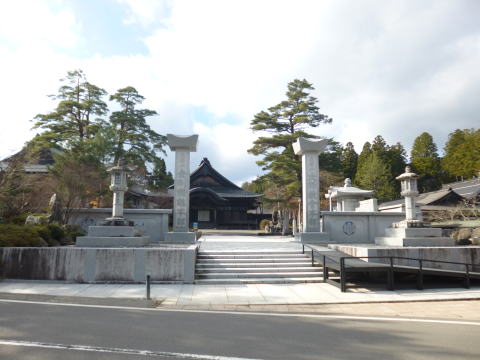
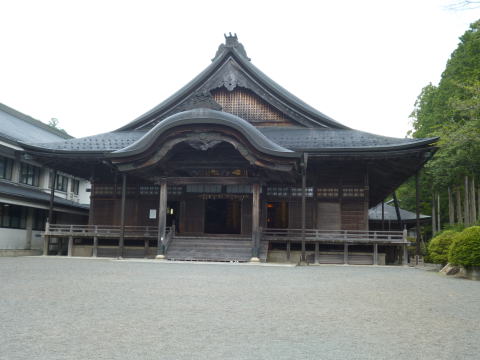
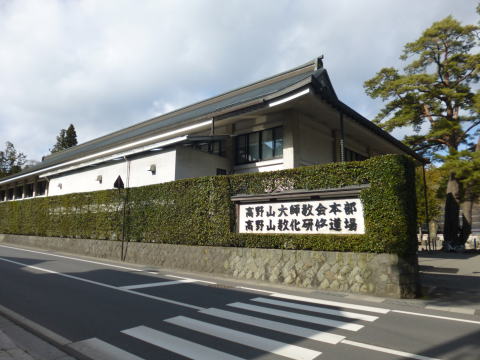
The Founder's Birthday Ceremony (The Aoba matsuri festival) ![]()
![]()
The Founder's Birthday Ceremony (The Aoba matsuri festival) is an annual
service held at Kongobu-ji Temple to celebrate the birthday of Kobo Daishi
(Kukai), and will be held at the Daishi Kyokai(Church) Daikodo (great hall
auditorium) from 9:00 a.m. on June 15th.
The Aoba Festival is organized by the Koyasan Hosankai, an organization
of Koya town residents, and various events will be held on June 14th and
15th.
A lantern procession will be held at the eve of the festival on the 14th.
The Hanamidou procession will depart from Okunoin Ichinobashi Bridge at
noon on the 15th, and elementary school drum and fife corps and singing
corps will parade through Koyasan together with people dancing to the "Daishi
Ondo," "Iroha Ondo," and "Chigo Daishi Ondo."
The Hanamidou hall houses a statue of the young Kobo Daishi, said to be
the image of Kobo Daishi as a child, and is guarded in front of and behind
it by the "Monmin Kushi (Imperial Envoy)" and the "Four
Heavenly Kings."
This is based on the story "Shiten Jiei" from the first volume
of Kobo Daishi Gyojyo Ekotoba (story book), in which a Monminkushi, a messenger
who traveled around Sanuki during the Nara period to ask about the hardships
of the people's lives, saw the four heavenly kings holding a canopy in
respect to the young Kobo Daishi playing with other children, and dismounted
from his horse to worship him.
In Mount Koya, there are also tribute exhibitions such as ikebana (flower
arrangenent) and calligraphy exhibitions, as well as tribute sports events.
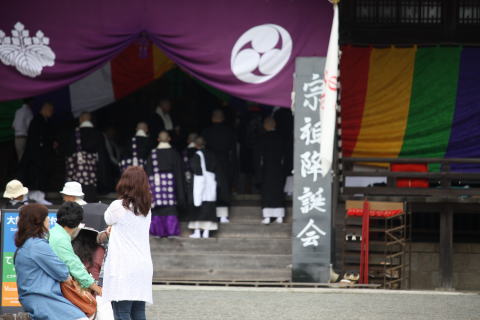
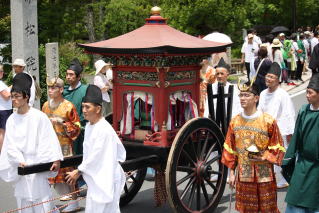
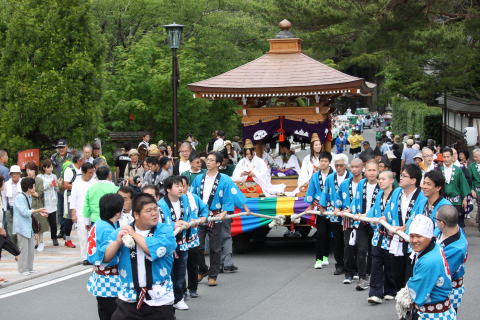
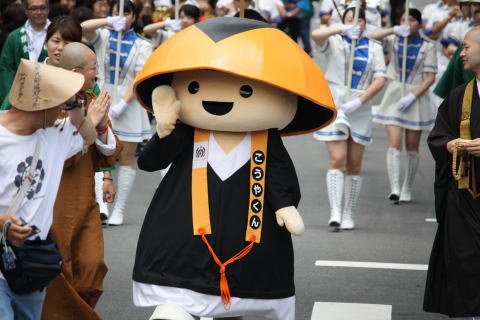
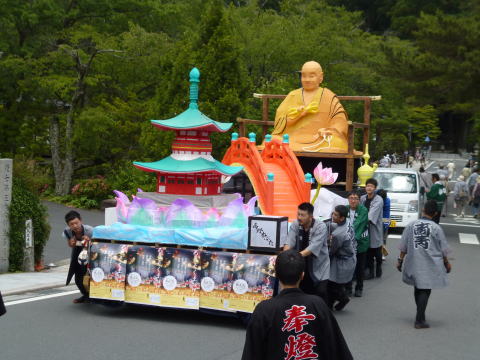
The Great Prajnaparamita Reading Ceremony ![]()
The Great Prajnaparamita Reading Ceremony is held at 9:00 am on December
10th every year at the Daikodo (Great Hall )of Koyasan Daishi Kyokai (Church).
The Great Prajnaparamita Sutra is an abbreviation of the Great Prajnaparamita
Sutra, which consists of 600 volumes (200,000 verses and 6.4 million characters)
and was translated by Xuanzang of the Tang Dynasty in China.
Xuanzang began translating the Great Prajnaparamita Sutra on January 1st
of the 5th year of the Junkei era (660), and completed the translation
at the end of October in the 3rd year of the Ryusaku era (663) after nearly
three years.
The following episode, which tells the story of the difficulties of translation,
is introduced in Hiro Sachiya's "The History of Buddhism" (6).
Because the original Indian text contains many repetitive expressions,
he wanted to translate it in a concise way that would suit the tastes of
Chinese people and focus on the content.
However, when Xuanzang started translating in this way, he had a frightening
dream.
So he changed the translation so that not a single word was omitted.
Then he began to have auspicious dreams, and completed the translation
while dreaming of Buddhas and bodhisattvas emitting light from between
their eyebrows.
The Great Perfection of Wisdom Sutra is one of the early Mahayana Buddhist
scriptures, and includes the Larger Perfection of Wisdom Sutra, the Smaller
Perfection of Wisdom Sutra, the Manjusri Perfection of Wisdom Sutra, and
the Diamond Perfection of Wisdom Sutra.
The sutra emphasizes the practice of the six paramitas of bodhisattvas
to reach this state of mind, particularly the attainment of the six paramitas
of wisdom.
The Great Perfection of Wisdom Sutra explains the various merits that can
be obtained by reciting, copying, and meditating on the sutra, and is therefore
considered to be useful for removing disasters, bringing good fortune,
and protecting the nation.
The Shoku Nihongi records that in the third year of the Taiho era (703)
during the reign of Emperor Mommu, the Great Perfection of Wisdom Sutra
was recited (repeated abbreviated reading of the title of the sutra or
a few lines from the beginning, middle and end of the sutra).
Since then, this recitation has been practiced regardless of sect.
At Koyasan Daishi Kyokai, the head priest Yamauchi and a monk from Kongobu-ji Temple are in attendance, and the sight of them holding the sutra in their left hands and spreading it out is very impressive.
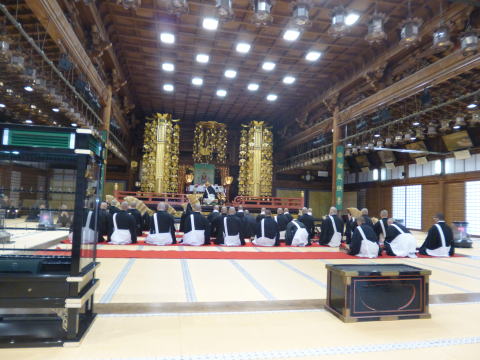

Experience (Practice)
Sutras
In this practice, the teachings of the Buddha are received directly in
a sermon from a high monk.
This is one of the most emblematic traditions of Mount Koya and is availble for participation year-round.
The Ten Precepts descrived therein were popularized through the ages as
an accessible form of teaching for lay people.
They describe codes of conduct that now, more than ever, are relevant to
modern society.
If people everywhere lend an ear to these precepts, we can achieve a better,
richer society.
They descrive proper conduct and poise of mind.
Start time 9:00 10:00 11:00 13:00 14:00 15:00 16:00
Lengh of prctice about 30 minutes
Entrance donation 1,000 yen per person